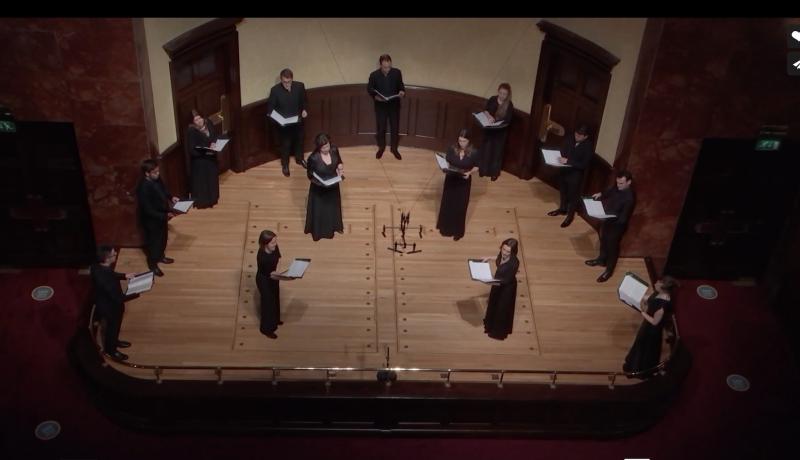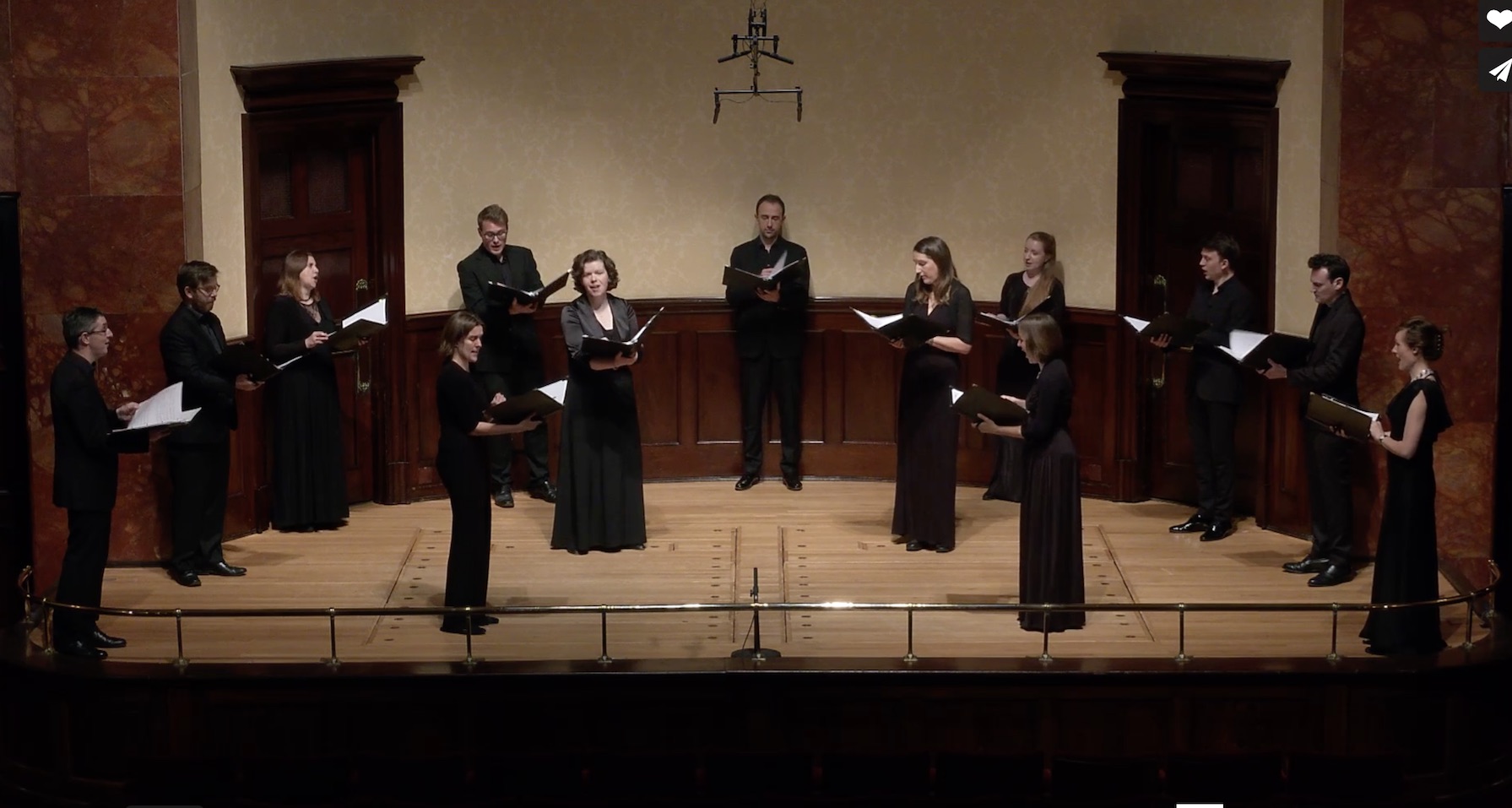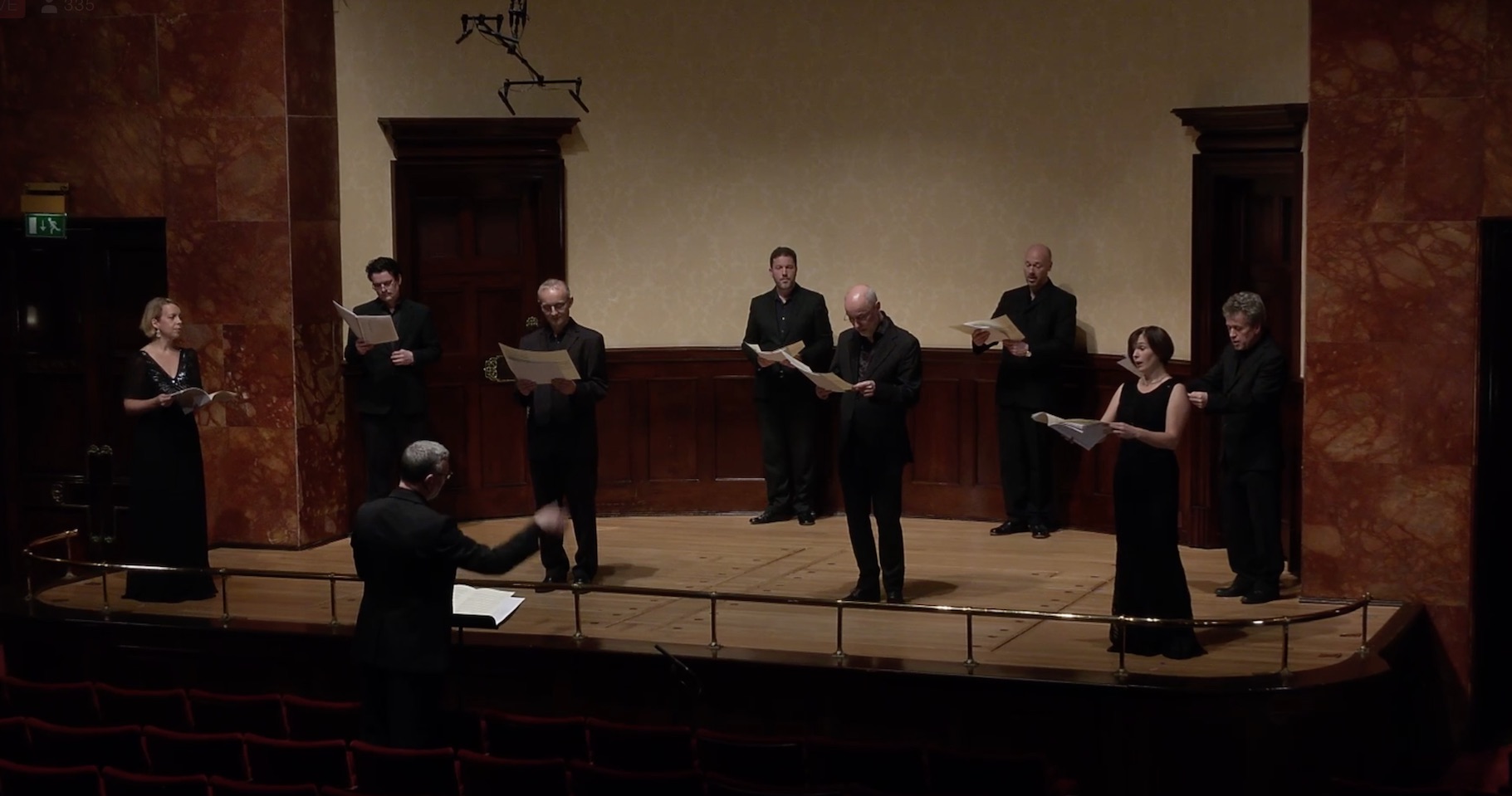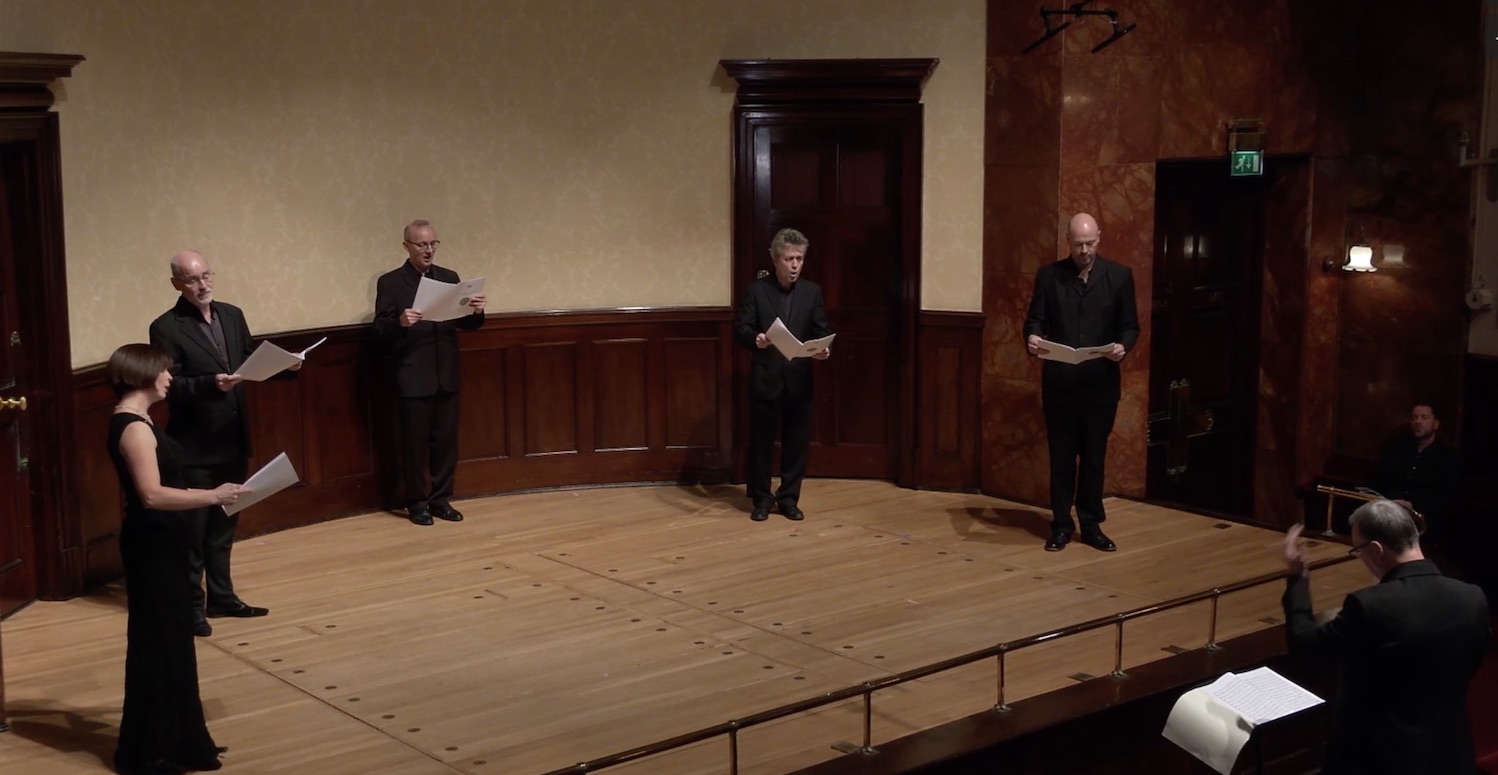Stile Antico, The Cardinall's Musick, Wigmore Hall online review – lightening our darkness | reviews, news & interviews
Stile Antico, The Cardinall's Musick, Wigmore Hall online review – lightening our darkness
Stile Antico, The Cardinall's Musick, Wigmore Hall online review – lightening our darkness
The rapt beauty of a Renaissance Christmas pierces the gloom

Suitably enough, this year’s musical Christmas arrived at the Wigmore not in a dazzle of joyful light and bedecked with winter greenery, but with a lonely band of singers facing the gloom of an unlit, empty hall as fear and confusion multiplied outside. In both of yesterday’s concerts, the closing events of the venue’s defiant and courageous autumn season, a cappella choral music from the Renaissance ushered in a festival more austere than ecstatic.
The 13 members of Stile Antico sang at lunchtime, and the eight-strong The Cardinall’s Musick – with director Andrew Carwood conducting – in the evening. Stile Antico presented a Spanish Nativity from the country’s Golden Age, revisiting the music from their seasonal recording last year. Its centrepiece was the 1602 Missa Beata Dei Genitrix by Alonso Lobo, preceded and intercut with rather folksier villancico numbers from the same period by other composers. They also enriched the Lobo mass with (for me) the only familiar piece in the programme: Victoria’s great motet O magnum mysterium: delicately shaped, fairly restrained, and so a bit less gut-punchingly spectacular than many versions sung by big forces in huge basilicas. Indeed, both of the day’s gigs deployed limited numbers with fine-focused precision. Both choirs, though, never lacked in sonic impact, and ensured that we didn’t miss a feeling of wall-of-sound polyphonic grandeur. They made the radiantly clear interaction of vocal parts a constant source of drama in itself. We heard more of the complex layering of line and texture that gives this repertoire such cumulative power.
 One regular pleasure of Christmas concerts is that, for once in the year, they allow hidebound divisions between art and vernacular music, sacred and secular styles, to dissolve. As interventions in Lobo’s gravely lovely Mass, 16th-century (or earlier) pieces such as the anonymous Ríu, ríu, chíu and Guerrero’s delectable A un niño llorando brought a flavour of the Spanish street and tavern Christmas into “church”. Mateo Flecha’s “ensalada” song El jubilate, for example, is a rhythmically nimble and witty mash-up that combines its singalong exuberance with episodes of rapt serenity. As they switchbacked between Mass and artfully madeover folk-tunes, Stile Antico [pictured above] showed off their versatility – in shading, phrasing and dynamics – as well as a crystalline purity of tone. They used the stage well, too (as did the evening’s performers), varying numbers and positions to enhance, and make audible, a sense of flexible architectural space. The ravishing cadences of Byrd’s Ecce Virgo Concipiet made for a spine-tingling encore full of finesse.
One regular pleasure of Christmas concerts is that, for once in the year, they allow hidebound divisions between art and vernacular music, sacred and secular styles, to dissolve. As interventions in Lobo’s gravely lovely Mass, 16th-century (or earlier) pieces such as the anonymous Ríu, ríu, chíu and Guerrero’s delectable A un niño llorando brought a flavour of the Spanish street and tavern Christmas into “church”. Mateo Flecha’s “ensalada” song El jubilate, for example, is a rhythmically nimble and witty mash-up that combines its singalong exuberance with episodes of rapt serenity. As they switchbacked between Mass and artfully madeover folk-tunes, Stile Antico [pictured above] showed off their versatility – in shading, phrasing and dynamics – as well as a crystalline purity of tone. They used the stage well, too (as did the evening’s performers), varying numbers and positions to enhance, and make audible, a sense of flexible architectural space. The ravishing cadences of Byrd’s Ecce Virgo Concipiet made for a spine-tingling encore full of finesse.
When, later, The Cardinall’s Musick took over the hall, the one conspicuous difference in their approach lay in Andrew Carwood’s presence as conductor. Stile Antico command such discipline and coherence in their sound that you could hardly claim that they ever (as it were) missed a beat. Pushed to define a distinction, you might say that Stile excel at a sort of collegiate consistency of tone whereas Carwood was able to steer his outfit [pictured below] through a slightly wider range of colours. And, whereas Stile gave us naked beauty without explanation, Carwood offered a useful, but not garrulous, commentary that sketched the background of his chosen pieces.
 So he described Palestrina’s own 1569 motet version of O magnum mysterium, which we heard first, as a sort of Lego kit that the composer later recombined into the Mass, using the same text, which followed. Five (at the end, six) of the Cardinall’s band sang the “ordinary” parts of the Mass while, in between, a couple of low voices contributed the “propers”: the plainsong verses specifically for Christmas morning. The result threw a more solemn, more liturgical mood over the performance, with Palestrina’s gorgeously interwoven lines still sounding more chaste than lush. At least, that is, until the Agnus Dei, when soprano melodies soar over deep harmonic seas beneath in one of those passages when sober Counter-Reformation black seems to burst out into quasi-operatic rainbow shades.
So he described Palestrina’s own 1569 motet version of O magnum mysterium, which we heard first, as a sort of Lego kit that the composer later recombined into the Mass, using the same text, which followed. Five (at the end, six) of the Cardinall’s band sang the “ordinary” parts of the Mass while, in between, a couple of low voices contributed the “propers”: the plainsong verses specifically for Christmas morning. The result threw a more solemn, more liturgical mood over the performance, with Palestrina’s gorgeously interwoven lines still sounding more chaste than lush. At least, that is, until the Agnus Dei, when soprano melodies soar over deep harmonic seas beneath in one of those passages when sober Counter-Reformation black seems to burst out into quasi-operatic rainbow shades.
This was singing of the highest order that demanded, and rewarded, rapt attention. Carwood described the music of Palestrina, who suffered from the plague and lost his wife to it, as “about bringing heaven to earth”. Here it was hard to disagree. After a pair of small choral gems by Schütz, our final visit to polyphonic heaven came via a setting of the Magnificat (1622) by the Hamburg organist-composer Hieronymus Praetorius – unrelated, it seems, to the better-known Michael. Interspersed with the Magnificat’s texts (as would have been the custom at the time), the choir added harmonised versions of two traditional carols: Josef lieber, Josef mein (set by Leonhard Schröter), and the ubiquitous In dulci jubilo – two verses set by a certain Walter, and two arranged by a rather more familiar figure: JS Bach.
 Expressive, and responsive, singing ensured that carols and liturgical music blended seamlessly. If, for the most part, yesterday’s Wigmore Christmas made for a muted and contemplative festival, here at last a taste of almost-Venetian sonic luxury and lavishness prevailed. The modest forces of The Cardinall’s Musick conjured not so much a mighty sound as an endlessly nuanced and variegated one. We even had delicious touches of Christmassy descant to add a sprig of holly to the cake. Once more, the Wigmore gave us something to sing about in the midst of wretched times.
Expressive, and responsive, singing ensured that carols and liturgical music blended seamlessly. If, for the most part, yesterday’s Wigmore Christmas made for a muted and contemplative festival, here at last a taste of almost-Venetian sonic luxury and lavishness prevailed. The modest forces of The Cardinall’s Musick conjured not so much a mighty sound as an endlessly nuanced and variegated one. We even had delicious touches of Christmassy descant to add a sprig of holly to the cake. Once more, the Wigmore gave us something to sing about in the midst of wretched times.
rating
Explore topics
Share this article
The future of Arts Journalism
You can stop theartsdesk.com closing!
We urgently need financing to survive. Our fundraising drive has thus far raised £33,000 but we need to reach £100,000 or we will be forced to close. Please contribute here: https://gofund.me/c3f6033d
And if you can forward this information to anyone who might assist, we’d be grateful.

Subscribe to theartsdesk.com
Thank you for continuing to read our work on theartsdesk.com. For unlimited access to every article in its entirety, including our archive of more than 15,000 pieces, we're asking for £5 per month or £40 per year. We feel it's a very good deal, and hope you do too.
To take a subscription now simply click here.
And if you're looking for that extra gift for a friend or family member, why not treat them to a theartsdesk.com gift subscription?
more Classical music
 Josefowicz, LSO, Mälkki, Barbican review - two old favourites and one new one
Julia Perry well worth her place alongside Stravinsky and Bartók
Josefowicz, LSO, Mälkki, Barbican review - two old favourites and one new one
Julia Perry well worth her place alongside Stravinsky and Bartók
 Classical CDs: Jelly Babies, porridge and kazoos
German art songs, French piano concertos and entertaining contemporary music
Classical CDs: Jelly Babies, porridge and kazoos
German art songs, French piano concertos and entertaining contemporary music
 Jean-Efflam Bavouzet, Wigmore Hall review - too big a splash in complete Ravel
Panache but little inner serenity in a risky three-part marathon
Jean-Efflam Bavouzet, Wigmore Hall review - too big a splash in complete Ravel
Panache but little inner serenity in a risky three-part marathon
 Karim Said, Leighton House review - adventures from Byrd to Schoenberg
The Jordanian pianist presents a magic carpet of dizzyingly contrasting styles
Karim Said, Leighton House review - adventures from Byrd to Schoenberg
The Jordanian pianist presents a magic carpet of dizzyingly contrasting styles
 Stile Antico, Wigmore Hall review - a glorious birthday celebration
Early music group passes a milestone still at the top of its game
Stile Antico, Wigmore Hall review - a glorious birthday celebration
Early music group passes a milestone still at the top of its game
 Hallé, Elder, Bridgewater Hall, Manchester review - premiere of new Huw Watkins work
Craftsmanship and appeal in this 'Concerto for Orchestra' - and game-playing with genre
Hallé, Elder, Bridgewater Hall, Manchester review - premiere of new Huw Watkins work
Craftsmanship and appeal in this 'Concerto for Orchestra' - and game-playing with genre
 First Person: young cellist Zlatomir Fung on operatic fantasies old and new
Fresh takes on Janáček's 'Jenůfa' and Bizet's 'Carmen' are on the menu
First Person: young cellist Zlatomir Fung on operatic fantasies old and new
Fresh takes on Janáček's 'Jenůfa' and Bizet's 'Carmen' are on the menu
 Classical CDs: Chinese poetry, rollercoasters and old bookshops
Swiss contemporary music, plus two cello albums and a versatile clarinettist remembered
Classical CDs: Chinese poetry, rollercoasters and old bookshops
Swiss contemporary music, plus two cello albums and a versatile clarinettist remembered
 La Serenissima, Wigmore Hall review - a convivial guide to 18th century Bologna
This showcase for baroque trumpets was riveting throughout
La Serenissima, Wigmore Hall review - a convivial guide to 18th century Bologna
This showcase for baroque trumpets was riveting throughout
 Sheku Kanneh-Mason, Isata Kanneh-Mason, Wigmore Hall review - family fun, fire and finesse
Intimacy and empathy in a varied mixture from the star siblings
Sheku Kanneh-Mason, Isata Kanneh-Mason, Wigmore Hall review - family fun, fire and finesse
Intimacy and empathy in a varied mixture from the star siblings
 Mahler 8, LPO, Gardner, RFH review - lights on high
Perfect pacing allows climaxes to make their mark - and the visuals aren’t bad, either
Mahler 8, LPO, Gardner, RFH review - lights on high
Perfect pacing allows climaxes to make their mark - and the visuals aren’t bad, either
 Philharmonia, Alsop, RFH / Levit, Abramović, QEH review - misalliance and magical marathon
Kentridge’s film for Shostakovich 10 goes its own way, but a master compels in his 13th hour of Satie
Philharmonia, Alsop, RFH / Levit, Abramović, QEH review - misalliance and magical marathon
Kentridge’s film for Shostakovich 10 goes its own way, but a master compels in his 13th hour of Satie

Add comment